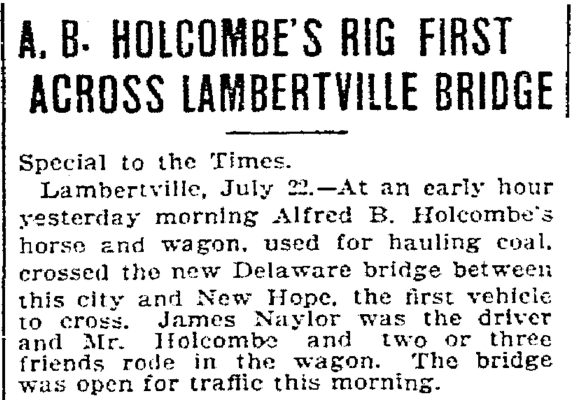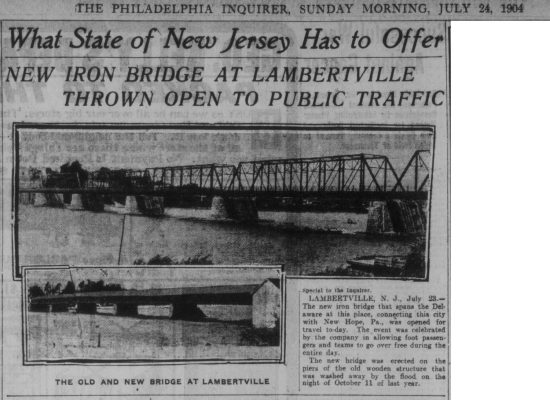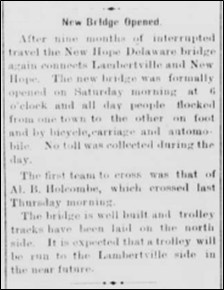NEW HOPE, PA. – The 120th anniversary of the current New Hope-Lambertville Toll-Supported Bridge’s opening is approaching — but the exact anniversary date is a befuddling mystery.
The bridge, which has been owned by the Delaware River Joint Toll Bridge Commission since July 1, 1987, replaced a former privately owned covered-wooden toll bridge that was destroyed in the Delaware River’s “Pumpkin Flood” of 1903. The flood’s name stemmed from the squash and gourds observed moving downstream in the river’s turbulent harvest-time surge.
The steel bridge was constructed between April and July of 1904 for the local shareholder-owned New Hope Delaware Bridge Company, which then operated it as a tolled crossing for the next 15-1/2 years. The company charged tolls in each direction to animal-power and early motorized vehicles, pedestrians, and bicyclists.
The bridge’s designer was Reginald G. Develin, a Pennsylvania Railroad civil engineer. The general contractor was Lewis F. Shoemaker & Co., which had offices in New York City and Philadelphia and construction-equipment yard and fabrication works in Pottstown, PA. The bridge’s main steel members were manufactured by the Cambria Iron & Steel Works in Johnstown, PA. The bridge originally had a wooden road deck installed by the Armstrong & Latta Co. of Philadelphia. The bridge’s original walkway had a wood surface and was only four-foot wide.
Now, on to the mystery: When did the steel bridge open? (See accompanying 1904 news clippings below.)
The Commission has previously stated that the completed or nearly completed bridge opened to the public on Friday, July 22, 1904. That date was based on a July 22, 1904 Trenton Evening Times newspaper clipping about a horse and wagon owned by Alfred B. Holcombe of New Hope and driven by James Naylor being the first to cross the bridge during the early part of July 21, 1904. The article – with a Lambertville, July 22 dateline – stated: “The bridge was open for traffic this morning.” (Note: The significance of Mr. Holcombe’s rig crossing the bridge was that it was last vehicle to cross the old wooden bridge before its demise in the Pumpkin Flood.)
Three subsequent news items published in July 1904 now put the July 22 opening date in doubt. One is a paragraph that appeared in the Trenton Evening Times’ July 21 edition: “Isaac Scarborough, who has charge of the ferry boat running between this city and New Hope, made his last trip yesterday afternoon at 3 o’clock. At that hour the new bridge was opened for traffic.” If that report is correct, the bridge opened 3 p.m. Wednesday, July 20, 1904.
Two other news articles suggest the bridge opened on Saturday, July 23, 1904.
One is a July 24, 1904 Philadelphia Inquirer article with a “Lambertville July 23” dateline that states the bridge opened with the bridge company allowing “foot passengers and teams” to cross that day free of charge. The other citation for a July 23 opening date is an item in the Lambertville Record’s July 27, 1904 edition. It says the bridge opened on Saturday morning (July 23) and “all day people flocked from one town to the other” with no tolls being collected.
The bridge-opening date certainly could be solved if meeting minutes were available for the second iteration of the New Hope Delaware Bridge Company. Unfortunately, those minutes and other documents appear to be lost – if they ever existed in the first place.
As for the bridge itself, it soldiers on. Aside for repair projects and flood emergencies, the bridge has been in service as either a privately owned tolled crossing or a publicly owned non-tolled crossing for 120 years.
The bridge is currently undergoing a multi-faceted rehabilitation aimed at putting it in a good state of condition, therby mitigating the need for major repairs and protracted lane closures for a minimum of 15 years. The bridge was last rehabilitated in 1904, the structure’s 100th anniversary year.
The New Hope-Lambertville bridge crossing is the fourth oldest along the Delaware River, dating back to a covered wooden bridge that opened September 12, 1814. This bridge was designed by American covered-bridge pioneer Louis Wernwag and was owned by the first iteration of the New Hope Delaware Bridge Company established in 1812. The bridge’s full ownership history is as follows:
- New Hope-Delaware Bridge Company (first iteration), private covered wooden toll bridge, Sept. 12, 1814 to March 15, 1850 (approximate);
- (Note: Half of the bridge [on New Jersey side] was destroyed in the January 1841 “bridges freshet;” three replacement spans subsequently were constructed later that year.)
- Honorable John Runk et al, court-appointed receivers later further empowered by legislative fiat in New Jersey and Pennsylvania, private toll bridge, Feb. 27, 1850 (approximate) to Apr. 4, 1854;
- John G. Michener and James Gordon, Philadelphia attorneys, private toll bridge, Apr. 4, 1854-Nov. 8, 1855 (possibly in connection with Samuel Grant of Philadelphia);
- Samuel Grant, Esq., Philadelphia shipper and importer, private toll bridge, November 8, 1855 to September 23, 1872;
- Estate of Samuel Grant, William S. Grant executor, private toll bridge, September 23, 1872 to May 11, 1887;
- New Hope-Delaware Bridge Company (second iteration), private toll bridge, May 11, 1887 to December 31, 1919 (property closing)-January 3, 1920 (effective date);
- (Wooden bridge destroyed by flood October 10-11, 1903.)
- States of Pennsylvania and New Jersey (jointly) with operation and maintenance assigned to the former so-called Joint Commission for Elimination of Toll Bridges across the Delaware River with costs covered by state tax subsidies, public non-toll bridge, December 31, 1919 (property closing date)/January 3, 1920 (effective date) to December 28, 1934;
- States of Pennsylvania and New Jersey with operation and maintenance assigned to the Delaware River Joint Toll Bridge Commission and costs covered by state tax subsidies, public non-toll bridge, December 28, 1934 through June 30, 1987;
- The Delaware River Joint Toll Bridge Commission (owner/operator) with costs covered by a portion of tolls collected at the agency’s highway toll bridges, public “toll-supported” bridge, July 1, 1987 to today.
A full and accurate historical account of the bridge crossing is available here: https://www.drjtbc.org/wp-content/uploads/NH-L_History_web_single-file.pdf.
In 2025, the bridge crossing is expected to reach the point where it will be in service longer as a publicly owned non-tolled facility than it was as a privately owned tolled operation.
1904 OPENING DATE DOCUMENTATION
From Trenton Evening Times, July 21, 1904:

From Trenton Evening Times, July 22, 1904:

From The Philadelphai Inquirer, July 24, 1904:

From The Lambertville Record, July 27, 1904 (Courtesy of Lambertville Public Library):

About the Commission
The Delaware River Joint Toll Bridge Commission was formed statutorily by the Commonwealth of Pennsylvania and the State of New Jersey in 1934 and Congress ratified the arrangement under the Compact Clause of U.S. Constitution in August 1935. The agency operates eight toll bridges and 12 toll-supported bridges, two of which are pedestrian-only spans. The Commission is a self-supporting public-service agency that receives neither federal nor state tax dollars to finance its projects or operations. Funding for the operations, maintenance and upkeep of its bridges and related transportation facilities is solely derived from revenues collected at its toll bridges. The Commission’s jurisdiction extends along the Delaware River from the Philadelphia-Bucks County line north to the New Jersey/New York border. More than 131.5 million cars and trucks crossed Commission bridges in 2023. For more information, please go to: www.drjtbc.org.
